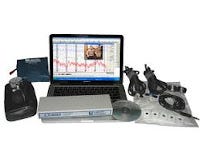Tens of thousands of Americans were polygraphed by the flawed LX4000 machine

Washington, D. C. - Police departments and federal agencies across the country are using a type of polygraph despite evidence of a technical problem that could label truthful people as liars or the guilty as innocent, McClatchy has found.
As a result, innocent people might have been labeled criminal suspects, faced greater scrutiny while on probation or lost out on jobs. Or, just as alarming, spies and criminals may have escaped detection.
The technical glitch produced errors in the computerized measurements of sweat in one of the most popular polygraphs, the LX4000. Although polygraphers first noticed the problem a decade ago, many government agencies hadn’t known about the risk of inaccurate measurements until McClatchy recently raised questions about it.
The manufacturer, Lafayette Instrument Co. Inc., described the phenomenon as “occasional” and “minor,” but it couldn’t say exactly how often it occurs. Even after one federal agency became concerned and stopped using the measurement and a veteran polygrapher at another witnessed it repeatedly change test results, the extent and the source of the problem weren’t independently studied nor openly debated. In the meantime, tens of thousands of Americans were polygraphed on the LX4000.
The controversy casts new doubt on the reliability and usefulness of polygraphs, which are popularly known as lie detectors and whose tests are banned for use as evidence by most U.S. courts. Scientists have long questioned whether polygraphers can accurately identify liars by interpreting measurements of blood pressure, sweat activity and respiration. But polygraphers themselves say they rely on the measurements to be accurate for their daily, high-stakes decisions about people’s lives.
“We’re talking about using a procedure that has a very weak scientific foundation and making it worse,” said William Iacono, a University of Minnesota psychology professor who’s researched polygraph testing. “I already don’t have very much confidence in how government agencies conduct these tests. Now, they might as well be flipping a coin.”
Despite the scientific skepticism, intelligence and law enforcement agencies see polygraph as useful in obtaining confessions to wrongdoing that wouldn’t otherwise be uncovered. Fifteen federal agencies and many police departments across the country rely on polygraph testing to help make hiring or firing decisions. Sex offenders and other felons often undergo testing to comply with probation or court-ordered psychological treatment. Police detectives and prosecutors rule out criminal suspects who pass and scrutinize those who don’t.
In its ongoing series about polygraph use by government agencies, McClatchy found that such testing has flourished despite being banned for use by most private employers 25 years ago. For federal jobs alone, more than 70,000 people are polygraphed each year, and most can’t challenge the results in court or allege abusive tactics. While supporters say accuracy can be 85 to 95 percent, polygraphs aren’t required to meet any independent testing standards to verify the accuracy of their measurements, unlike medical or other computerized equipment.
The concerns about the LX4000 only add to the criticism.
“If you buy all of the propositions that the physiological measurements are a reliable proxy for truth telling or deception, then the whole premise depends upon a machine that can precisely record those measurements,” said Gene Iredale, a San Diego attorney. “If you don’t have that, then you have a hope piled on a speculation, and on top of it all an error-filled system.”
In the absence of an independent assessment, polygraphers depend on the federal government, the manufacturer or one another to be notified of a problem with the technology. Many polygraphers, however, told McClatchy they didn’t know about the possibility of inaccurate measurements or that they could occur in other polygraphs that use the same technology.
http://www.mcclatchydc.com/2013/05/20/191542/glitch-in-widely-used-polygraph.html


